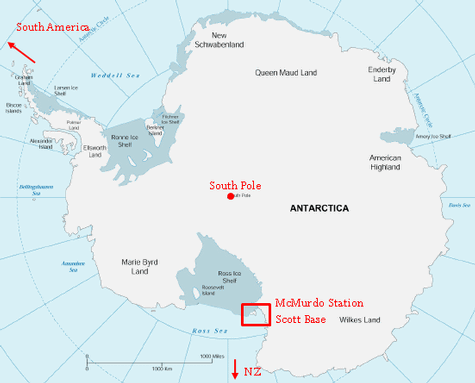Hollistonian in Antarctica
The following article was written by Michelle Brown for STATESMAN.com. Published: 7:53 p.m. Saturday, Oct. 29, 2011:
Their enthusiasm is contagious as they read League's responses to questions they posted to him the week before. I watch their eyes widen and jaws drop as they learn new facts about underwater organisms in the Antarctic, and I realize that I've signed myself up for the right trip. I am an eighth-grade science teacher at O. Henry Middle School, and in November, I will begin a six-week stay in Antarctica, working with scientists at McMurdo Station and a remote site outside of the South Pole on their research projects and communicating back to my classroom through an online blog.
(The Polar Club talks to the McMurdo research team (from left to right, Terry Palmer, Stephen Sweet and Andrew Klein)).
I am part of a program called PolarTREC (Teachers and Researchers Exploring and Collaborating), which is funded by the National Science Foundation and administered by ARCUS (Arctic Research Consortium of the United States) and PolarTREC. Each year PolarTREC sends a handful of K-12 educators from around the country to the Arctic and Antarctic to work with scientists and communicate back to classrooms and the public about what they are learning.
I applied to be a PolarTREC teacher because I wanted to improve my science knowledge and skills as a researcher. I was frustrated that I was not involving my students in real science research and the excitement that goes along with it. Seeing my students now, I feel as though I have tapped into something that is hard to evoke from a textbook, activity, or PowerPoint presentation alone.
One of my classes recently participated in a live webinar in which another PolarTREC teacher and his research team gave a presentation on their work in Antarctica. I passed out paper to each of my students, hoping a few would come up with a question to ask the research team. During the presentation, I was amazed to see my eighth-grade students on the edge of their seats with questions for scientists flying out of their hands. At the end of class, an overflowing pile of my students' questions sat on my desk. I had sparked their interest in science. PolarTREC allows my students to be part of science that is important, exciting and bigger than their classroom.
PolarTREC has also impacted my own identity as a teacher. When I started teaching, I was determined to reach all of my students and make them see the wonder and excitement of science. This was my way of righting the misguided science education that I was taught as a student, packed with worksheets and textbooks and little I could grasp. However, with each passing year, it is harder to maintain my determination and enthusiasm while trying to balance a packed curriculum, standardized testing and engaging lessons. Although I am satisfied with the job I have done, I know I can do more. Working with PolarTREC has given me a renewed strength to make a real difference in my students' lives.
(Michelle dressed up in Extreme Cold Weather (ECW) gear at an elementary school visit)
It is not just my own students with whom I am interacting. PolarTREC encourages teachers to reach out to other schools and the community at large. I have received many invitations to visit elementary, middle and high schools so that they can also participate in my expeditions. Every week I visit at least one school, my hands heavy with a globe, laptop, camera and the extreme cold weather gear I will wear on the ice. Classrooms decorate a flag that I will take with me to Antarctica and photograph. As students try on the heavy red jacket and huge, insulated boots, they gain an experience that will connect them to a place 8,500 miles away.
I have visited six classes, and they include a range of economic and ethnic backgrounds. All the students I meet display the same joy and excitement as they try on the clothes and ask questions.
Upon leaving one school, a fifth-grade girl ran up to me with her email address written on a scrap of paper. "Promise you'll write to me in Antarctica?" she asked. Her eagerness to interact with me reaffirms the importance of the PolarTREC program. Before I leave each class, a group photo is taken. When they read my science journals, they will remember me in their classroom - a photograph of us hangs on their wall to remind them. When they see the flag they decorated at the South Pole and read my responses to their questions on the PolarTREC blog, they become part of the experience. The personal connection I share with students in their classroom is the key to sparking their interest in polar science.

You can read Michelle's journal by going to: http://www.polartrec.com/expeditions/human-impacts-in-antarctica-2011
Way to go Michelle! I love your enthusiam for teaching and your quest to make it an exciting adventure for your students. They are lucky to have you.
sue s | 2011-11-14 13:44:22